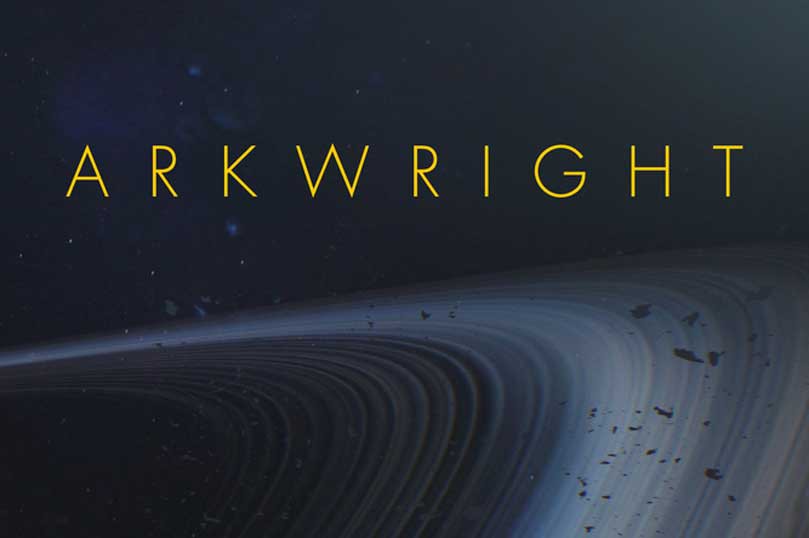opens in a new window Written by Allen M. Steele
Written by Allen M. Steele
The short answer to that question is: because science fiction says it should. My novel Arkwright explains why this is.
Arkwright came out of the Starship Century symposium held in May, 2013, at the Arthur C. Clarke Center of the University of California – San Diego. Attending the conference were A-list scientists, futurists, and SF writers including Freeman Dyson, Joe Haldeman, Robert Zubrin, David Brin, Jill Tarter, Geoffrey Landis, Neal Stephenson, and dozens more, including myself. Anyone who enjoys serious, non-dystopian SF would have loved being there.
Like its predecessor, the 100 Year Starship conference held two years earlier in Orlando, Florida, the two-day symposium focused on the near-term prospects for interstellar travel. Coinciding with the UCSD gathering was the publication of an anthology, Starship Century: Toward the Grandest Horizon, edited by symposium organizers James Benford and Gregory Benford. Nearly all the Starship Century participants contributed to the anthology, which included both fiction and non-fiction, and just before the symposium, Jim Benford emailed PDFs to all the authors so we could discuss the book in San Diego.
I read the book during my long flight from Connecticut to California by way of Texas, and noticed something interesting: while most of the SF stories—including my own—presumed that interstellar missions would be undertaken by starships manned by human crews, most of the non-fiction pointed out all the problems inherent with putting living, breathing people aboard such vessels and keeping them alive and well for dozens, or even hundreds, of years. If one rules out FTL travel as physically impossible—Einstein said it, I believe it, and that settles it—and also accepts the fact that starship drives using warp engines or wormholes will be extraordinarily difficult (if not impossible) to achieve, then our prospects for sending humans beyond our solar system are limited to a small handful of choices.
Furthermore, if biostasis or another form of suspended animation is the only way to keep a ship’s passengers alive during the long period it would take to reach even a nearby star like Alpha Centauri, then suddenly Lost in Space becomes more plausible than Star Trek (talking vegetables notwithstanding). And while generation ships make for great SF stories, novels from Robert Heinlein’s Orphans of the Sky to Kim Stanley Robinson’s Aurora point out all the ways these things could go wrong. Indeed, the generation ship is a concept that makes less sense the more closely it’s examined. So it seems that the only reason why people would be aboard starships in the first place is because SF writers insist that they should be… and I’m just as guilty as my colleagues for saying so.
Then a new thought occurred to me. If the biggest impediment to interstellar travel is caring for the needs of a human crew, then what would happen if we removed people entirely? You’d have an unmanned starship such as the Daedalus or Icarus probes proposed by the British Interplanetary Society: a sophisticated AI-controlled vessel capable of making the journey without human control.
Suppose, though, there was a way to put humans aboard a microwave-sail vessel like the one proposed by Jim Benford in his article, not as fully-formed people, but rather as reproductive material capable of being genetically modified and gestated in artificial wombs, as Freeman Dyson proposed in his essay. Then half the difficulty of building and launching a starship is eliminated, because you no longer have to worry about keeping your crew alive, healthy, and sane.
This is the game SF writers call “What If?” I spent most of my time at the symposium playing it, and it led to fascinating conversations with Jim, Freeman, and other participants. Never before had I brainstormed a novel so quickly. By the time I flew home I’d filled half a notebook with material I’d eventually use, and a few months later I began work on what became Arkwright.
Arkwright is about generations-long effort to build and launch humankind’s first starship. It’s also about how science and science fiction feed each other, the way in which imaginative visions are transformed into reality. And it’s kind of a long answer to the question I posed in the title of this essay.
Buy Arkwright today:
Amazon | Barnes & Noble | Books-a-Million | iBooks | Indiebound | Powell’s
Like Allen M. Steele on Facebook and follow his website for updates.







1) It’s been done. Why can’t I think of the name of that classic with the colony ships with just one person and a hoard of eggs?
2) In my writing, I’m forcing the humans to be present. While AIs are the only system that can handle the massive calculations to travel through hyper, AIs are terribly unstable and need to be bonded with a stable intelligence like a human. The irony isn’t lost on me.
This concept was explored in the “2001 Nights” manga and anime (Japan, mid ’80s) (https://en.wikipedia.org/wiki/2001_Nights).